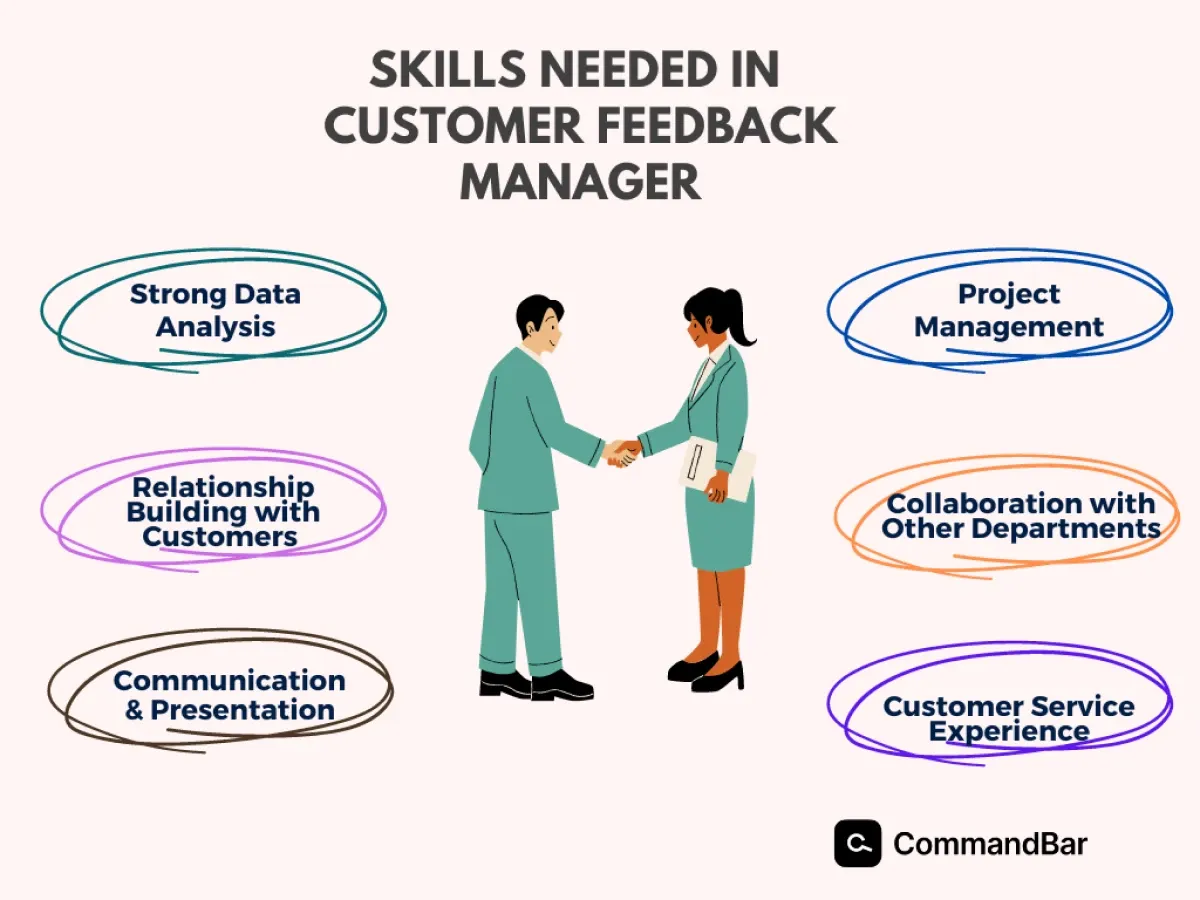Once upon a time, businesses held significant sway over the market, dictating terms under which they wanted to operate. Henry Ford's infamous "any customer can have a car painted any color that he wants so long as it is black" policy exemplifies this era, prioritizing production efficiency over consumer choice.
But such days are long past. Today, the customer dictates how far and fast a business will grow. Their opinions, preferences, and experiences shape the evolution of products, especially those in the B2B SaaS world.
It is imperative to understand and respond to customer feedback – it's now the only way to build serious and loyal relations with end-users, gain a competitive edge, and maintain a leading status in the industry.
Such customer feedback management lies in the hands of a customer feedback manager.
What is wrong with traditional feedback collection?
Getting customer feedback used to be time-consuming and an ineffective process. Businesses relied on surveys or email questionnaires to ask the customer how they liked the product or what more they wanted in it – and such methods can be costly, take forever to compile, and frankly, yield limited insights.
One of the primary drawbacks is the low response rate typically associated with these methods. Customers are often inundated with requests for feedback and may simply choose to ignore them. Furthermore, the delayed nature of traditional feedback collection hampers a business's ability to respond promptly to evolving customer needs. By the time data is collected, analyzed, and acted upon, market conditions may have shifted, rendering the insights less valuable.
Moreover, surveys and questionnaires often rely on closed-ended questions, restricting respondents' ability to provide nuanced feedback. This can lead to a distorted picture of customer sentiment and missed opportunities for product improvement.
Bring in the customer feedback manager
To rectify the shortcomings of traditional feedback collection, the role of a customer feedback manager emerges as a critical asset in B2B organization. This strategic position demands a dedicated individual responsible for optimizing the entire customer feedback lifecycle – from initial collection to in-depth analysis and subsequent action.
A customer feedback manager is the bridge between customers and the organization. They are tasked with developing and implementing a comprehensive feedback strategy, ensuring that customer voices are heard and valued at every level of the business. By centralizing feedback management, this role eliminates silos and makes a truly customer-centric culture possible.
Moreover, a customer feedback manager possesses the skills to transform raw data into actionable insights. They can identify trends, patterns, and areas for improvement, providing valuable guidance to product, marketing, and customer support teams. Ultimately, their goal is to create a feedback loop that continuously enhances the customer experience.
What exactly does a customer feedback manager do?
When it comes to customer feedback, a lot is supposed to happen. Collect feedback, analyze it, look for gaps and improvements that can be made in your product, pass on that information to the relevant stakeholders (usually to the product management or product marketing teams), and act on those valuable customer insights.

If you were keen to break it down into a list of roles and responsibilities, this is what it would look like –
- Develop and implement a comprehensive customer feedback strategy that gets customers to respond.
- Design and manage feedback collection channels – including in-app surveys, chatbots, 1-on-1 calls, and even social media.
- Analyze the feedback to identify trends, patterns, and any new opportunities to make your product even more "wow".
- Transform insights into actionable recommendations for the internal stakeholders.
- Collaborate with other teams to bring those insights to life.
- Measure the impact of feedback-driven initiatives.
- Communicate the customer insights and actions being taken to internal stakeholders as well as the customers.
How a customer feedback manager fits in a B2B SaaS organization
Aligning the business around customer feedback
It is up to the customer feedback manager to build a culture that prioritizes customer feedback. With support from senior leaders, the customer feedback manager can communicate the importance of feedback from customers and the role it plays in achieving business goals. This involves creating a shared vision where stakeholders from different departments understand how their role contributes to the overall customer experience.
Creating a feedback loop – from collection to action
It isn't enough to simply collect customer feedback. A customer feedback manager needs to make sure that any relevant insights are actually acted upon. This means creating a process that translates feedback into insights and then transforming them into actionable initiatives or product roadmap features.
What does such a feedback loop look like?
- Collection: Gather feedback using various channels. This could be done via in-app surveys, chatbots, and social media.
- Analysis: Process and analyze the feedback to identify key trends and patterns.
- Prioritization: Determine which feedback items need to be addressed based on impact and feasibility. This should happen in consultation with the relevant departments.
- Action: Implement changes based on customer insights and communicate them to both internal as well as external stakeholders.
- Measurement: Evaluate the impact of changes on customer satisfaction and business outcomes – that after all is the core aim of any customer feedback mechanism.
Automating feedback collection to beat traditional and slow-moving processes
Some things are better automated and collecting customer feedback is one of them. It can help increase efficiency, reduce time to create, set up, and communicate "questions" and even provide insights in real-time. Not to mention, automated processes mean consistency in the feedback collection process and more reliable data.
Use chatbots for real-time feedback
Chances are, if you have a serious B2B SaaS product in play, it’s highly likely that your product already incorporates a chatbot, either developed in-house or one that leverages a best-in-class industry solution such as Command AI.
Chatbots not only help resolve customer queries but can also ask targeted questions to gather qualitative feedback through open-ended responses. What's great about such a collection channel is that a customer feedback manager can receive responses in real time, resolve issues promptly, and pass on key insights to product management, marketing, and customer services teams.
Leverage micro surveys to get to the heart of true feelings
Microsurveys are short, focused surveys that can be deployed at specific touchpoints in the customer journey – which makes them another great tool to truly understand how much (or how little), the customer loves your product.
To be effective, customer feedback managers should create micro surveys that are concise, relevant, and easy to complete – no customer wants to spend too much time answering questions to vendor surveys. By asking clear and targeted questions, you can gather valuable insights without overwhelming customers or wasting their time.
How a customer feedback manager creates impact
Meeting product owners on an equal footing
If you don't get the right and relevant customer feedback, version 2.0 of your product may not quite be as successful as you want it to be. By coming to the table together, a customer feedback manager along with a product owner or product manager can secure these wins –
- Identify new product opportunities
- Prioritize feature development
- Improve existing products based on customer feedback
- Reduce product failures by anticipating customer needs
The parameters of success as a customer feedback manager

Demonstrating the value of customer feedback processes becomes important for securing ongoing support from leadership. This is best done by calculating the impact the customer feedback manager has on customer success initiatives.
- Identify cost savings: Quantify reductions in customer support costs attributed to feedback-driven improvements.
- Measure revenue growth: Determine the increase in sales or revenue attributed to feedback-informed product enhancements or marketing campaigns.
- Calculate customer lifetime value (CLTV): Assess the long-term value of customers whose experiences have been improved through feedback.
The customer feedback manager is the voice of the customer
Henry Ford’s rigid approach to production would undoubtedly struggle in today's marketplace – customers have their own expectations and can frankly, be unforgiving if you don't listen to them. The onus is on businesses to evolve continuously, aligning their offerings with what customers want.
Customer feedback managers serve as the prime mover in this process. By systematically collecting, analyzing, and disseminating customer insights, they empower organizations to make decisions, especially related to products using quantitative and qualitative data.
Their role extends beyond mere data collection; they are instrumental in prioritizing feature development, ensuring that customer feedback directly influences the product roadmap – businesses create what customers truly want. Moreover, by effectively communicating product upgrades and changes, they strengthen customer relationships as anything that is coming up is transparently conveyed.

















